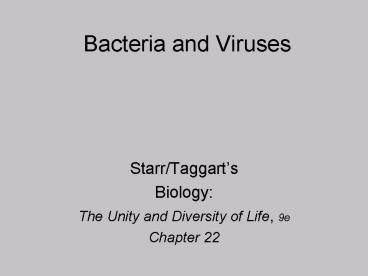Bacteria and Viruses - PowerPoint PPT Presentation
1 / 21
Title:
Bacteria and Viruses
Description:
Helical= rod-shaped protein coat wound helically around nucleic acid core ... Acidic soils, hot springs, coal mines, hydrothermal vents. Eubacteria: Photoautotrophic ... – PowerPoint PPT presentation
Number of Views:570
Avg rating:3.0/5.0
Title: Bacteria and Viruses
1
Bacteria and Viruses
- Starr/Taggarts
- Biology
- The Unity and Diversity of Life, 9e
- Chapter 22
2
Virus Key Concepts
- Are non-cellular infectious agents.
- Their general structure includes a protein coat
surrounding a nucleic acid core. - They are DNA or RNA based.
- DNA mutation rate is lower than RNA rate.
- Implications for treatment etc.?
- They reproduce inside a host cell.
3
Viral Shapes (Morphology)
- General Structures
- Helical rod-shaped protein coat wound helically
around nucleic acid core - Polyhedral many-sided coat
- Enveloped Envelope around virus is made mostly
of membrane remnants from previously infected
cell - Complex has additional structures attached to
the protein coat
4
viral RNA
protein subunits of coat
18-nm diameter, 250-nm length
80-nm diameter
lipid envelope proteins span the envelope, line
its inner surface, and spike out above it
DNA
protein coat
sheath
viral RNA
base plate
tail fiber
reverse transcriptase
viral coat (proteins)
Fig. 22.16, p. 364
65-nm diameter head, 225-nm total length
100-120 nm diameter
5
Viral Multiplication Cycles
- 5 Steps
- Attachment
- Penetration
- Replication
- Assembly
- Release
- Lytic pathway
- Host cell lysis relatively immediate
- Lysogenic pathway
- Viral DNA integrates into bacterial chromosome,
there is a period of dormancy
6
LYTIC PATHWAY
e Lysis of host cell is induced infections
particles escape.
d Tail fibers and other parts are added to coats.
a Virus particles bind to wall of suitable host
cell. Viral genetic material enters cell
cytoplasm.
c Viral protein molecules are assembled into
coats DNA is packaged inside.
Fig. 22.18a, p. 366
7
LYSOGENIC PATHWAY
prophage
http//static.howstuffworks.com/gif/virus-human-ly
sogenic.gif
8
- The Lysogenic Cycle Example
- Some viruses, like phage lambda, can enter a
lytic cycle or alternatively, may enter a
lysogenic cycle. - Phages that can multiply by either cycle are
lysogenic or temperate phages. - When lambda enters a lysogenic cycle, its DNA
recombines with E. colis chromosome. - The inserted phage DNA is called a prophage.
- Repressor proteins, which are products of the
prophage, prevent transcription of the other
prophage genes. - As a result, the synthesis and release of new
phages is repressed. - Every time the bacterial chromosome is
replicated, prophage DNA is replicated, as well. - The prophage can remain latent in the bacterial
chromosome for many generations. - A spontaneous event at any time may cause the
virus to break out of its latent state and enter
the lytic cycle.
http//plato.acadiau.ca/courses/biol/Microbiology/
virus.htm
9
Viral Applications
- Bacteriophages as antibiotics
- As transduction tools
- Gene therapy applications
10
Viruses and the Diversity of Life
- Are viruses alive?
- The safest response is that they have both living
and nonliving characteristics. - Where do viruses fit into the phylogeny project?
- They are on their own currently. All viruses are
placed within the Order Mononegavirales.
11
Virus Taxonomy
- Based mainly on Virion and Kingdom of host
- Use Host cell type (Animal viruses, plant
viruses, etc.) - Use Nucleic Acid type (ds DNA, ss DNA, ds RNA, ss
RNA) - Use or - polarity of RNA. "" is able to serve
as mRNA. "-" is the complement of , must
function as template to make a complementary
strand of RNA before any translation can occur.
- Use virus coat morphology. Enveloped vs.
non-enveloped viruses.
http//www.sp.uconn.edu/terry/229sp03/lectures/vi
ruses.html
12
Bacteria Key Concepts
- The simplest forms of life are bacteria
- Bacteria are the only prokaryotes
- Bacteria reproduce by binary fission
- The first living organisms on earth were
theorized to be bacteria - Different lineages of organisms arose from
bacteria
13
Bacterial Structure
14
Bacterial Classification
- Based on characteristics from next slide
- Also based on gene sequencing and comparative
biochemistry
15
Characteristics of Bacteria
- Metabolic Diversity
- Photoautotrophic
- Chemoautotrophic
- Heterotrophs
- Sizes and Shapes
- 1 - 10 micrometers
- Coccus
- Bacillus
- Spirillum
- Structures
- Cell walls
- Peptidoglycan
- Membrane
- Glycocalyx
- DNA in cytoplasm
- Flagella
- Gram strain
16
Bacterial ReproductionBinary Fission
17
Binary Fission
18
Binary Fission
19
Endospores
- Resting structure formed by some bacteria
encloses a duplicate of the bacterial chromosome
and some cytoplasm
2.2 µm
Fig. 22.13, p. 363
20
Archaebacteria
- Methanogens
- Swamps, sewage
- Extreme Halophiles
- Brackish ponds, salt lakes, hydrothermal seafloor
vents - Extreme Thermophiles
- Acidic soils, hot springs, coal mines,
hydrothermal vents
21
Eubacteria
- Photoautotrophic
- Cyanobacteria
- Ponds and freshwater
- Chemoautotrophic
- Cycling of N2 , S2
- Chemoheterotrophic
- Most bacteria
- Normal flora
- Pathogenic
- Endospores































